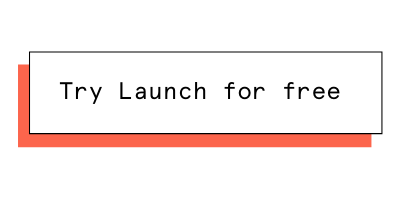Successful Kickstarter creators know that mobilizing backers from past campaigns can help get a new project funded early. But what’s the best way to encourage your existing community to pledge to your upcoming campaign? Before you launch a Kickstarter project, sending a few messages to everyone on your email list may generate some awareness. But when your end goal is to get people to pledge to your campaign, awareness alone isn’t enough — you need to turn past backers into repeat backers.
To leverage your existing fanbase for Kickstarter success, you will have to be strategic about how, when, and what you’re communicating to your audience. Take the following steps to maximize the potential of your email list, and hit your funding goal.
Step 1: Verify the strength of your email list
Having hundreds of people on your email list is great. But if these people aren’t actually interested in the projects you’re working on, then they’re not much use to you. After taking time to build an email list, you must ensure that your list is full of qualified contacts who have interacted with you or your brand in a meaningful way.
Typically, email contacts gathered from previous projects you’ve run, in-person events and conventions, and via social media and online forum communities work best. While it may be tempting to buy an email list or hire a third-party to build a list, you’ll notice that conversion rates will be much lower if you go that route.
One of the easiest ways to start building an email list of fans is by creating a landing page, and then directing the people you connect with through networking, conventions, playtesting events, online groups to the page. Anyone can use BackerKit Launch to create a landing page begin collecting authentic email contacts.
The first 48 hours of your Kickstarter campaign are critical. Starting strong, with a significant number of day-one pledges, sets the pace for the rest of your campaign. That initial momentum is also the key to bringing more attention to your project on Kickstarter. As a Kickstarter creator with a qualified email list of fans, you’re better equipped to secure those early pledges.
Step 2: Assess the impact previous backers had on past campaigns
If you are a repeat creator, you can take an even deeper look at the strength of your list and the power of your audience by paying attention to your returning backers. Previous backers are your most passionate fans and likely to be your biggest supporters at the start of a project. They’re also essential to long-term Kickstarter success.
The most successful creators are able to maintain a consistent level of support from their fans with each new campaign. This faithful group of backers make it possible for the top creators to launch new, successful projects every year. Collecting and analyzing data on previous backers’ pledge behavior and the monetary impact they had on your last campaign gives you a glimpse into how well your upcoming projects will perform.
You can easily and quickly review this data with BackerKit Launch — an email marketing tool specifically designed for crowdfunding creators. Import past projects directly from Kickstarter or Indiegogo into Launch, and you’ll get a breakdown of the number of backers you had for each of your past projects and what percentage of your pledges came from past backers. You can also see how many times individual contacts pledged to your previous campaign and exactly how much they contributed.
Monte Cook Games used Launch while promoting their recent project, Ptolus: Monte Cook’s City by the Spire. When taking a look at their backer data, they saw that 58% of their total backers were returning backers and their biggest pledge day for returning backers was day one.
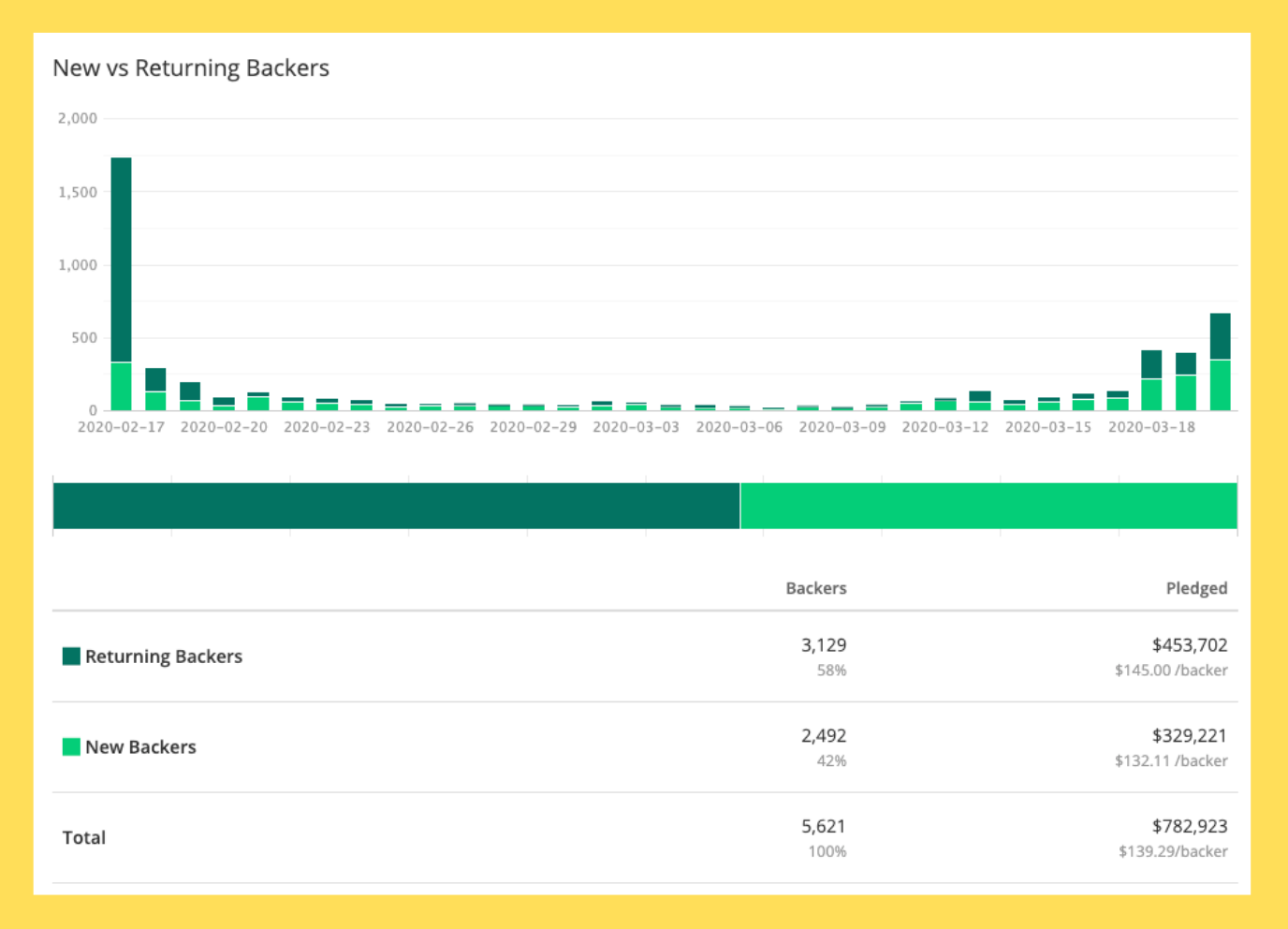
Your previous backers have a major impact on how well your project does in the first 48 hours of your campaign. So if you want to hit your goal early, it’s important that you nurture the relationships you have with this segment of your community and engage them in the days leading up to your campaign.
Step 3: Create a messaging plan
Sending the right messages at the right time is essential to activating your community. If you’re using Launch to reach your previous backers, developing a messaging strategy is a cinch with the platform’s email templates. Here are some general content and timeline tips to help you craft your messages, whether you’re using a template or decide to create custom email campaigns.
Before launch
About a week before you launch, start building some hype about your campaign. Let your community know why you’re launching this project, tell them what problem your product solves, and give them a glimpse at the development process, prototype, or some other kind of exciting sneak peek. You can create a landing page in Launch or direct people to your Kickstarter preview page to share even more information like videos or behind-the-scenes stories.
You can also use this email to direct people to your Kickstarter Pre-Launch page to gain followers. According to our research, 20-25% of the followers on your Pre-Launch page will end up pledging, so it’s important to drive people to this page.
Launch day
As soon as your Kickstarter project is live, send out an announcement to your email list with a link to your project page. While your previous email built excitement, the messaging here should be a push to pledge to your project. Incentivize your audience by promoting Early Bird specials or first access to limited pledge levels.
After launch
Two days after launching, send a reminder message to motivate people who haven’t pledged yet. If you’re using BackerKit Launch, you will be able to identify these people easily because they will be grouped into a customer segment. Since people who haven’t pledged won’t be getting notified of project updates made on your Kickstarter page, you can duplicate those updates for this segment of your email list.
During your campaign
At the project midpoint, send another update. Let your audience know how many days are left in the campaign, and how important their support is to you. This is also a great time to tell them about any stretch goals that have been met.
Project ending
In the last 12-24 hours of your campaign, send a final reminder email out to those subscribers who still haven’t pledged. Let them know exactly how much time they have left, and make sure to highlight any benefits of pledging while the campaign is live.
Adjusting the timeline to fit your campaign
Depending on the duration of your campaign, how close you are to hitting your funding goal, and your own preferences, the number of emails you send during each of these points can vary. But in general, the moments listed above are when people are most likely to pledge.
Monte Cook Games adapted the timeline to fit their needs, but still made sure to communicate to their audience at key points throughout their campaign. They first sent an email announcing their project, and asking backers to pre-commit to pledging.
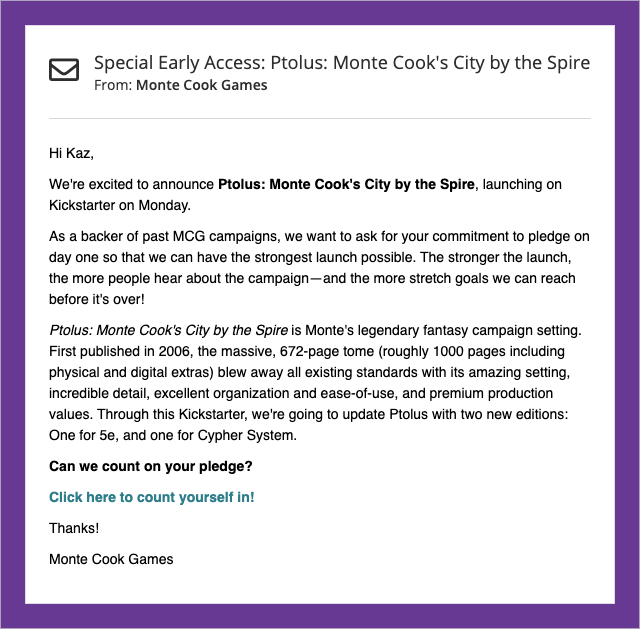
Another email was sent when the project was live that explained pledge levels and the importance of pledging early.
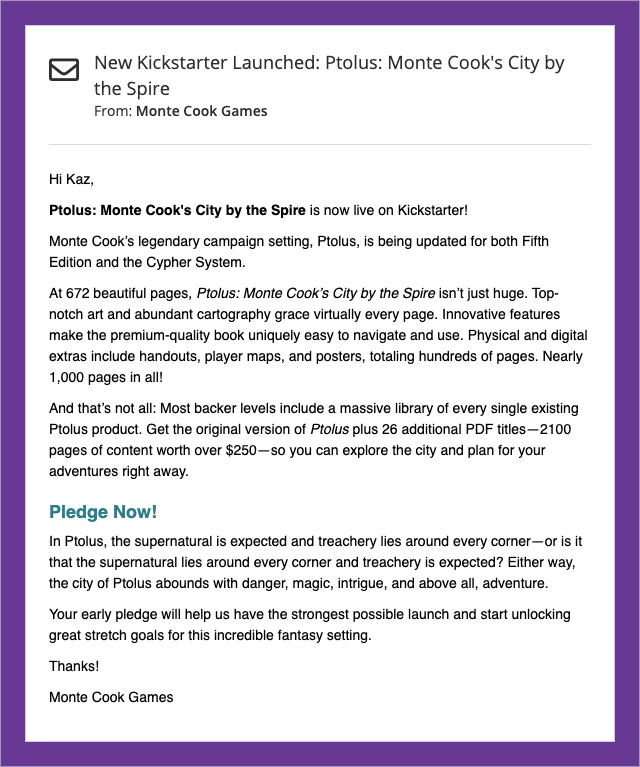
A third email updated their audience on the project’s progress while encouraging them to pledge.
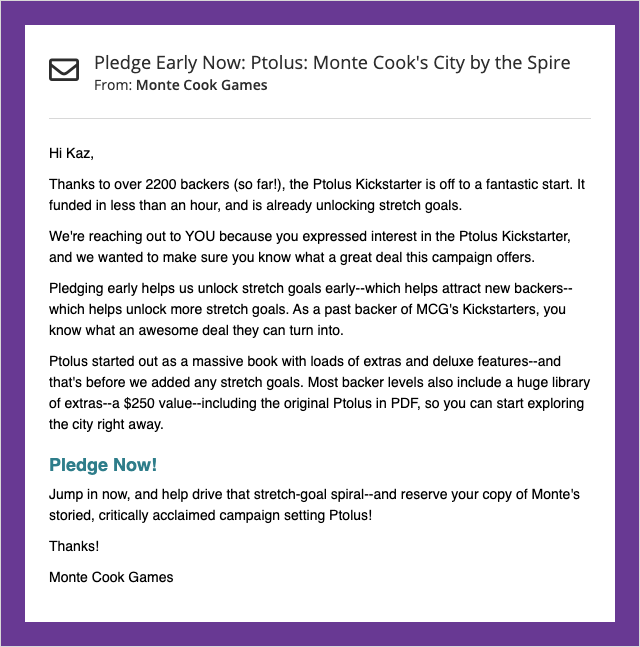
Their final email before the campaign ended explained that they’d unlocked their stretch goals and urged their audience to pledge before time ran out.
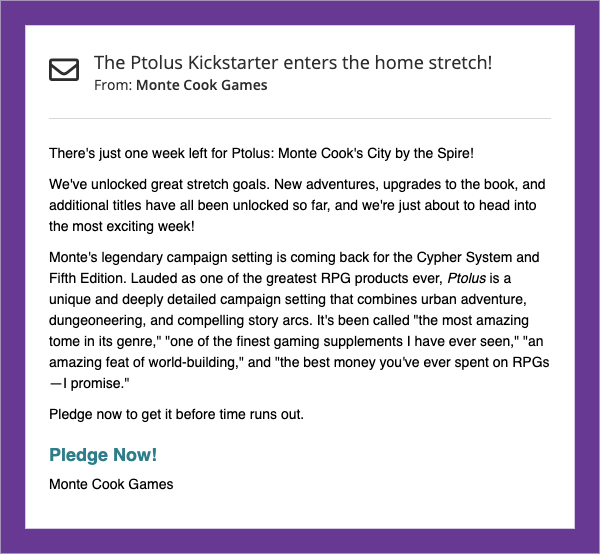
In the end, with the help of this type of strategic messaging, they raised $276,524 through Launch.
Step 4: Track pledges in real-time and refine your messaging
No one wants to waste time on email tactics that aren’t translating into pledges. With so many other tasks on your campaign to-do list, you need to be as efficient as possible. To see how your outreach efforts are directly affecting your campaign, use BackerKit Launch to track pledges.
Launch will automatically generate a custom Kickstarter referral URL for the associated project for each email campaign. This enables you to track pledge progression using Kickstarter’s own referrer technology. You will be able to see exactly who pledges to your campaign in real-time.
In addition to observing conversion rates, you can use this data to create tailored messages for your audience. Divide those who have pledged to your campaign and those who haven’t into distinct segments. For anyone who hasn’t pledged, you can send optimized reminders like project updates, reasons why they should pledge, and alert them to any other incentives.
This kind of segmentation is important. It enables you to send targeted messages to those who may need a little extra encouragement to pledge and filters out people who’ve already converted, preventing you from over-messaging them. It may seem obvious, but the most effective marketing emails contain content that is relevant to the reader. In fact, recent statistics show a 760% increase in email revenue from personalized or segmented campaigns. Being mindful of which members of your audience are receiving which messages not only helps drive more pledges, but also gives backers a better experience.
Before launching a Kickstarter campaign, it’s important to take a close look at your email list and develop a messaging strategy. There shouldn’t be any surprises about how well you do on day one of your campaign if you communicate properly with your audience, examine how past campaigns performed, and anticipate how your previous backers will convert. Have you run a Kickstarter campaign? Import your past projects into BackerKit Launch, and explore your backer data today. 